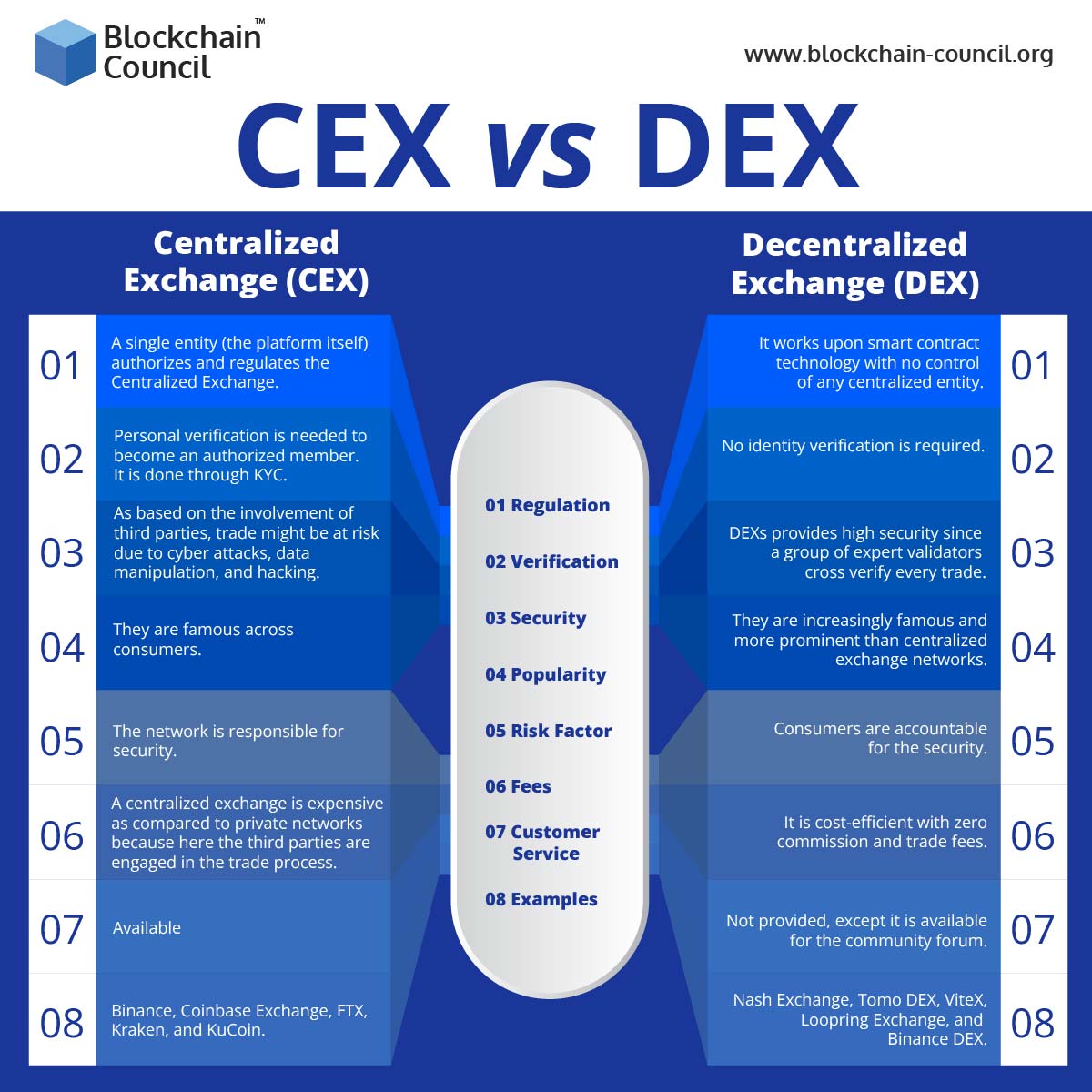
- Blockchain Council
- September 08, 2022
DEXs have gained traction due to the excitement around decentralized financial solutions (DeFi). The sudden quick switch to Uniswap, a decentralized exchange, has generated debate among the traders regarding the benefits and drawbacks of decentralized vs. centralized exchanges (CEX).
Numerous blockchain enthusiasts anticipate that the customer base of decentralized exchanges will skyrocket in the next few years. Several recognized crypto exchanges are also being developed as decentralized versions of their blockchain exchange platforms to find distinctions between various transactions. As a user, do you think cryptocurrency trading will truly decentralize in the long run?
Let us understand the difference deeper, but before that, let us understand the theory around Centralized Exchanges (CEX) and Decentralized Exchanges (DEX).
CEX (Centralized Exchanges)
Centralized exchanges with their own order book include Binance, CEX.io, Kraken, Coinbase Exchange, and OKEx. The order book records and authenticates all cryptocurrency-related transactions. The information is passed internally through the efficient network and is protected by consolidated security mechanisms. As per the protocol, CEXs have an extensive built-in know-your-customer policy and operate under regulatory supervision. In order to avoid financial fraud, centralized exchanges relentlessly prosecute fraudsters in compliance with existing legislation.
Amateurs favor this kind of trade due to the availability of a centralized structure that allows a consumer-friendly interface for acquiring and managing virtual currency smoothly.
The frequency of requests and transactions on DEX is often much larger than on CEX. The reason behind it is the fact that network nodes do not require real-time updates. As a result, trading executes at an extremely fast rate. The private keys of the connected wallets must, however, remain on the exchange due to the platform’s flexibility. As a result, exposure to crypto-assets is directly linked to the user’s credentials. If a scammer hacks the passwords through a security breach, they will have immediate access to the investor’s stored crypto assets.
A for-profit corporation acts as a backbone to CEX and provides a wide variety of support services in order to gain a positive customer experience. They also allow the users to trade cryptocurrencies against fiat currency and generally have a large number of trade pairings. Fixed costs are charged while trading on centralized exchanges.
A crypto exchange, like any other exchange, operates on the same principles. A matching algorithm is followed to control the market dynamics, and transactions are maintained in an order book.
How does the centralized exchange work?
Centralized exchanges are totally managed and owned by a single authority, and traders must place their confidence in this centralized authority in order to conduct more exchanges. Let us consider the example of stock exchanges to understand the functioning of CEX better.
Most consumers are familiar with stock exchanges, where stocks are purchased, sold, and traded at real-time values.
A centralized exchange functions similarly to a stock market, except instead of stocks, it permits the purchase, sale, and exchange of virtual currencies. To be a user, one must undergo KYC (know your customer) verification. ID evidence, name identity, full permanent address, and biometrics verification are all common types of verification available to become a registered user.
Once authenticated, the exchange provides the users with their login information so that they can easily access their accounts, go through the rules and regulations, and begin trading.
Additionally, members on controlled exchanges cannot directly swap assets. Instead, the exchange assumes custody of assets deposited by users and releases an equivalent quantity of IOUs to dealers, which they may only transfer at the moment of withdrawal. Because it’s an unofficial document confirming the debt one entity owes to another, IOUs perform the function of smart contracts in centralized blockchain exchanges.
Centralized exchanges use the Order Book technology to conduct transactions. The order book keeps track of all pending transactions so that traders may purchase and sell securities accordingly. For example, if a buyer wishes to purchase a certain item, they must inform the exchange’s broker of the asset’s anticipated cost.
When the intermediary finds a purchaser whose requirement fits the buyer, the assets are exchanged, and the transaction is completed. However, order books include drawbacks, such as a significant delay for the exchange to complete and the incapacity of dealers to cross-check the deal.
DEX (Decentralized Exchange)
The blockchain-platform-based decentralized exchange lets anyone transfer various digital assets on a safe and open market with no middlemen. DEXs have all of the capabilities of a centralized exchange, but they stand out for making it easier to exchange all of the currencies that are accessible online. As a result, traders won’t have to worry about limiting coin listings on DEXs.
DEXs are frequently built on the Ethereum network and utilize Ether (ETH) as their primary currency. Other crypto coins might potentially be used as a framework base, but Ethereum has by far the highest financial market holding. As a result, these are also not based on the transfer price and are not following a single platform.
Consumers of decentralized exchanges use exchanges such as Uniswap, Bisq, and GDEX. The reason for trusting these DEXs is confidentiality and the availability of heavy reliability features. In addition, DEX is considered anonymous since exchanges need practically minimal customer information.
To operate on a decentralized exchange, users usually simply need a public address. In addition, as a decentralized program, there are no external third parties (officials or regulatory agencies) overseeing or enforcing rules on the exchange. Its high-security level is another reason for its growth and popularity.
However, CEX customers have no authority over their secret information, and DEXs do not have an inbuilt smart wallet; therefore, users retain control of their secret information.
How does decentralized exchange work?
Multiple variations of decentralized exchanges have evolved over time. While the initial DEXs used the order books, which function similarly to centralized exchanges and financial markets, the most recent decentralized exchanges employ an automated broker-dealer. Let’s look at both ways to learn more.
-
Method of the order book
To coordinate asset purchases and sales, an order book collects and manages open orders. A person who wishes to purchase a certain asset must provide the item’s expected cost to the smart contract. When the smart contract identifies someone whose requirement fits the buyer’s, the assets are swapped, and the client receives the item she was interested in purchasing.
To do so, if someone wishes to sell their assets, they must submit the request to a smart contract to achieve its goals. Then, they should wait for the platform to locate acceptable purchasers for the assets under evaluation. In any case, the system may go through the order book, locate a purchaser, accept their conditions, and finish the transaction.
Advantages and disadvantages of CEX and DEX
Advantages of CEX:
The user interfaces are simple to grasp for novices, and the methods may be swiftly absorbed. Access to the various cryptocurrency trading platforms is easy and straightforward, with an overall great degree of functionality and a variety of trading choices available.
The cryptocurrency expert advisors believe that because of CEX’s large trading volume, it enjoys a greater cash flow. The trades can smoothly and quickly complete their payment obligations. The frenetic activity on centralized trading platforms ensures a huge number of buyers and sellers, resulting in market-friendly trade.
CEX is a firm structure supported by a centralized and individual infrastructure. This enables rapid real-time transactions. Thus to build strategic competitive advantages, they are algorithmically capable of processing several orders per second. As a result, participants in the market can make quick decisions and respond swiftly to changing market conditions.
The biggest traditional exchanges provide a wide range of virtual currencies and trading pairs. Simultaneously, the option for withdrawals and deposits in fiat currency is also available.
Disadvantages of CEX:
The exchange is where people store their digital currencies. It is critical that the client has no control over the integrated wallets because they are components of the system. Because the exchange owns the private keys, there is a danger of complete loss if the exchange succumbs to vulnerabilities. However, instances like these are uncommon, but they have happened before, with losses occurring billions.
Authorities, external party operators, and legal teams all have control over centralized trades, which is an argumentative disadvantage. In addition, providers are obligated to gather detailed data from their customers in order to prevent financial fraud. This system is itself contradictory to the prime idea of cryptocurrencies.
Advantages of a DEX:
In decentralized exchange, government guidelines, restrictions, and system monitoring are not present. Participants trade directly with each other, with no external member like an intermediary engaged in the trade. Each client has full control over their private keys and thus on their crypto assets.
One of the major highlights of trading on a DEX platform rather than a centralized platform will always be user anonymity. There is no identification process, no KYC, and no personal information stored on foreign servers. The exchange process may generally start with a user’s personal address required on the relevant blockchain. There is no confidential data exchange between the exchange and the authorities.
To enable low-cost trading with a large number of trade pairs, a decentralized server network is deployed. This drastically reduces the chances of a system breach and virtually eliminates the risk of inaccessibility due to server failure. Furthermore, a DEX cannot target a central server as it directly resides on the blockchain.
Disadvantages of a DEX:
Trading on a decentralized exchange is typically much slower than trading on a controlled exchange. This is because miners must validate each transaction, which differs according to DEX to DEX. As a result, decentralized exchanges are unsuitable as a trading venue when it is important to react to changing market conditions quickly.
A successful exchange requires high liquidity. Therefore, the widely traded platforms are always the ones with the exchanges having the highest liquidity.
Due to the newness of the idea of decentralized exchanges, there are many fewer traders than on CEX. As a result, liquidity is severely reduced.
DEX’s usefulness is currently restricted. Furthermore, the graphical user interface is sometimes too complex for beginners. Moreover, many traders do not have access to limit orders, margin transactions, or stop losses. However, most decentralized exchanges are focused on implementing the CEX-like functionality.
CEX vs. DEX — What are the differences?
Summary: CEX vs. DEX
Decentralized financial applications (DeFi) have sparked a push for decentralized trades because of the surge in demand (DEX). An exchange that works directly on a cryptocurrency without a central governing institution is referred to as this form of the trading venue. DEX enables traditional cryptocurrency trading as among the complete kinds of decentralized apps. The benefit is that users may trade right away without signing in, and they always have access to their private credentials.
Centralized exchanges, on the other hand, are called CEX. A CEX is a cryptocurrency exchange that runs on its own equipment. In comparison to a DEX, the exchanges are always managed via an external party. The high liquidity and quick transaction interchange of centralized exchanges attract its users. In this case, however, the consumer is completely reliant on the transaction and has no control over his login details.
Both sorts of transactions have their own set of benefits and drawbacks. However, the success of CEX strongly advocates for the usage of conventional platforms for several traders. Apart from this, many CEX has realized the authority distributed throughout decentralized trades and are already improving their own variations or inbuilt DEX features into their networks. Therefore, it will lead to the upcoming mergers of the two variations at the appropriate interfaces that are feasible.
If you aspire to become a cryptocurrency developer, then you have clicked at the right place. Blockchain Council offers some of the best cryptocurrency courses according to the present industry trends and at a budget-friendly price. You need to search out for the course that best suits your expectations and get started!






































































 Guides
Guides News
News Blockchain
Blockchain Cryptocurrency
& Digital Assets
Cryptocurrency
& Digital Assets Web3
Web3 Metaverse & NFTs
Metaverse & NFTs
